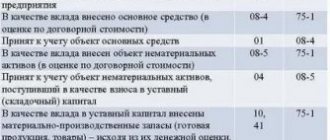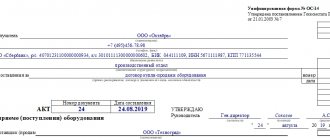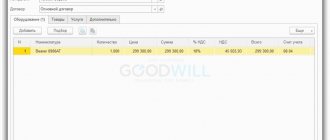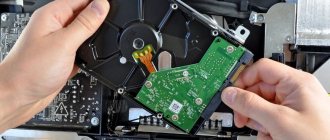Some of the fixed assets entering the organization may require installation. Such fixed assets include, for example:
- equipment put into operation only after it has been assembled and attached to the foundation (supports, floors, floors and other load-bearing structures of buildings and structures);
- control and measuring equipment or other devices intended for installation as part of the installed equipment, etc.;
- external and internal video surveillance cameras designed for installation as part of a video surveillance system.
Definitions and criteria
Fixed assets are tangible assets that:
a) are intended for use in the production or supply of goods and services, for rental or administrative purposes;
b) are expected to be used for more than one reporting period (clause 6 of IAS 16 “Fixed Assets”).
In accordance with paragraph 7 of IAS 16, an object is recognized as an asset only if:
- it is probable that future economic benefits associated with the item will flow to the entity;
- the original cost of the article can be reliably estimated.
If the definition and criteria are not met, the object cannot be recognized as a fixed asset and is recognized as either a stock or an expense of the current period. However, in practice, companies also use one more criterion - the cost criterion when recognizing fixed assets. The standards themselves do not contain the concept of a cost criterion. The cost criterion comes from paragraph 31 of IAS 1 “Presentation of Financial Statements”. According to it, a company is not required to comply with a specific disclosure requirement of any IFRS unless the relevant information is material. At the same time, the company determines the materiality threshold for the purposes of recognizing fixed assets under IFRS independently and establishes it in its accounting policies.
I would also like to note that the use of the cost criterion makes it possible to bring accounting under IFRS and RAS closer together, because in Russian standards the cost criterion is enshrined in law.
However, the cost criterion in relation to one asset does not always work unambiguously. The fact is that in cases where low-value objects in the total amount constitute a significant amount and if the period of use of these low-value objects exceeds 1 year, they should not be recognized as expenses, but are recognized on the balance sheet. Thus, the procedure for applying the cost criterion in one case or another varies.
As we see, at first glance, standards and accounting policies provide us with a reliable guide to the procedure for recognizing fixed assets. However, not all so simple.
Classification of industrial equipment according to other parameters
An additional classification of industrial equipment is also provided based on the following indicators:
- by specialization;
- by method of influence;
- by design features;
- by type of material being processed;
- according to the type of energy used.
By specialization
Based on this parameter, industrial equipment can be universal or specialized. The first option is unified. It can be used to perform different tasks from a variety of industries. Specialized equipment is developed and produced for the specifics of a certain production and the type of work to be done, in particular products for the food, woodworking, pharmaceutical industries, etc.
By method of influence
This refers to the way the equipment affects workpieces or processed surfaces. The following types are distinguished:
- chemical,
- thermal,
- mechanical.
Chemical involves exposure to aggressive environments, thermal - high or low temperatures, mechanical - mechanical forces.
By design features
Industrial equipment may have technological-energy mechanisms or engineering devices. The first category includes equipment that is used in the production process, in particular hydraulic machines and transformers. Engineering devices include devices that are most widely used in communication networks, as well as elevators and escalators.
According to the type of material being processed
Machine equipment is classified according to this criterion. It could be:
- woodworking;
- metalworking;
- for chipboards;
- for processing artificial and natural stone;
- for working with polymer materials;
- for stone processing;
- for working with ceramic products, etc.
Each of these categories of machines has its own specifics. This is an example of specialized industrial equipment.
<< Popular Stationary crushers
By type of energy used
Industrial equipment can receive energy from electrical networks, be driven by the energy of compressed air or liquid, gasoline or other types of liquid, solid, or gaseous fuel. Based on the type of energy used, electrical, hydraulic, pneumatic, diesel and other types of equipment are distinguished.
Another classification is based on transportation conditions. It can be sized or oversized.
offers industrial equipment in Rostov-on-Don in a very wide range. The product catalog presents to customers all kinds of machines, mechanisms, robots and components for them, intended for use in various industries. Products are supplied to any region of Russia, as well as to Ukraine, Moldova, Belarus, Kazakhstan and other CIS and European countries. All equipment is new, certified, and has a manufacturer's warranty.
find out more about the terms of cooperation and prices of industrial equipment from the company’s consultants by phone or through the online form.
How to classify an object?
You need to start by testing the object for compliance with the definition of an asset classified as a fixed asset, that is, it is necessary to understand for what purpose the asset is being acquired, and also determine the period of its use. The purpose of the acquisition and the technical service life, as a rule, are clarified with technical specialists or the curator of the asset acquisition agreement. If at least one of the two points of the definition is not met, then you can immediately refuse to recognize the fixed asset in the balance sheet. However, the item may turn out to be a stock, in which case it is still necessary to test the asset recognition criteria.
Assessment of criterion 1. Likely future economic benefits
The ultimate goal of acquiring any asset by any organization is to directly or indirectly increase the profitability of the company (through savings or actual return on funds). Examples include: increased sales as a result of opening a new office; release of a new product line and, as a result, launch of a new production line; organizing employee safety through the installation of security systems; saving electricity through the purchase of modern, energy-efficient equipment at the factory, etc. Businesses usually do not acquire objects if there is no likelihood that there will be no return from this acquisition.
When assessing this criterion, you must first pay attention to probability. Probability, as you know, is a very subjective assessment. However, it can be calculated mathematically. As a rule, in the case of large investment projects, a detailed assessment of cash flows is carried out, and the probability of obtaining profitability has not only a numerical value agreed by the business in the form of net present value (NPV) or another indicator, but also the timing of the return flow of cash (payback). When acquiring small objects, profitability is not always considered or is not always calculated correctly. And in some companies, the acquisition of an object does not always go through the proper levels of approval, i.e. it may come as a surprise to the business. Therefore, management is not always ready to give an IFRS specialist a correct assessment of the likelihood of future economic benefits and an assessment of the risks associated with the acquisition of a given asset.
At the same time, the standard cannot directly help an IFRS specialist. The IAS 16 standard does not define probability and does not indicate at what probability of future cash flows we can consider an asset to be an item of property, plant and equipment, and at what degree we cannot. Therefore, in the absence of other data, you can use your own professional judgment, as well as other standards such as IAS 37, to determine the probability value. When forming a professional judgment, it is necessary to take into account all known facts relating to the transaction at the date of recognition of the asset.
Criterion 2. Reliable assessment
This criterion is quite simple in practice. With any acquisition of an asset, a two-way contract arises, which specifies the cost of the acquisition. Problems of reliable assessment can arise only in the case of any inherently unique objects that have no analogues on the market. However, in practice these cases are extremely rare.
Source No. 2 - MDS 81.37-2004
Before the cancellation of MDS 81.37-2004 “GUIDELINES FOR THE APPLICATION OF FEDERAL UNIT PRICES FOR INSTALLATION OF EQUIPMENT” (CANCELED from July 1, 2017. Order of the Ministry of Construction of Russia dated June 30, 2021 No. 946/pr), the separation of materials and equipment was regulated by:
clause 2.7.3
Estimated prices for materials accepted according to the Federal Collection of Estimated Prices for Materials, Products and Structures have a seven-digit code .
If there are no material resources specified by the project in the nomenclature of the Federal Collection, their cost should be determined on the basis of calculations, taking into account documented costs for containers, packaging, transportation and procurement and storage costs, markups of supply, marketing and intermediary companies.
and 2.7.5
Materials and products for industrial and technical purposes that are not included in unit prices and are not included in the lists of unaccounted materials as part of technical parts , introductory instructions or appendices to FERM collections should be classified as equipment .
After the cancellation of this MDS, these items were not included in the current Methodological Recommendations on the application of federal unit prices for construction, special construction, repair and construction, installation of equipment and commissioning works (pr. 81/pr dated February 9, 2021).
Complex examples of recognizing objects as fixed assets
Example 1 Classification of spare parts as current period inventory/expenses
According to paragraph 12 of IAS 16, the company does not recognize in the book value of an item of property, plant and equipment the costs of day-to-day maintenance of the item. These costs are recognized in profit/loss as incurred. Routine maintenance costs consist primarily of labor and consumables, but may also include costs for minor components (spare parts). In practice, these costs are called “repair and routine maintenance costs” of a fixed asset item. In this case, there are no differences from RAS and, as a rule, no adjustments need to be made.
However, spare parts are not always recorded initially as inventories and are subsequently written off for repairs. Accounting items such as spare parts, standby equipment and auxiliary equipment are recognized in accordance with IAS 16 if they meet the definition of property, plant and equipment. Otherwise, such items are classified as inventories (clause 8 of IAS 16). That is, spare parts can be capitalized on the balance sheet as fixed assets if they meet the criteria for fixed assets. At the same time, there is no such clause in PBU 6/01, so you can’t count on correct data in RAS in this part. If a company has spare parts, backup and auxiliary equipment that meet the criteria for property, plant and equipment under IFRS, you need to be prepared to review its recognition and possibly make adjustments.
Example 2 Classification of spare parts as fixed assets
An item of property, plant and equipment that contains replaceable parts has been purchased. Along with this item, in addition to it, a replacement spare part of significant cost and with a service life of more than 1 year was purchased. In this case, according to paragraph 8 of IFRS (IAS) 16, two fixed assets are accepted on the balance sheet: the object itself and the spare part for it. They will begin to depreciate at the same time. In this case, recognition criterion 1 is met: it is obvious that the company incurs costs for the purchase of spare parts in order to obtain future economic benefits (continuous operation, reduction of production risks, etc.). Criterion 2 is also met (the cost is determined). The definition of a fixed asset is also fulfilled, since the cost is significant and the period of use exceeds 1 year.
The one-time recognition approach upon transfer to production does not apply to spare parts that require regular replacement. This is reflected in paragraph 13 of IAS 16.
Thus, in paragraph 13 the following examples of replacement of parts are given: the furnace requires replacement of the lining after a specified number of hours of use, and the internal equipment of the aircraft, such as seats or galleys, must be replaced several times during the life of the fuselage. Why can't replacing these items be counted as normal repairs? Replacement means installing in place of any part of an object a new one, similar in quality to the one being replaced. The need for replacement is due to the discrepancy between the useful life of the object as a whole and its individual parts. An object can serve for 20 years, but any part of it can only serve for 5 years. In these cases, the organization must recognize in the book value of an item of fixed assets the costs of partial replacement of such an item at the time of their occurrence, and write off the replaced (old) item as expenses. These costs fully comply with criterion 1: without a doubt, the organization bears them in order to obtain future economic benefits, sometimes even with the aim of increasing the productivity of the operating facility. Moreover, criterion 2 can also be assessed in this case - based on the cost of incurring costs.
This criterion is almost always included as an element of the description of the accounting policy for fixed assets. An example representation could be as follows:
If an item of fixed assets consists of separate components with different useful lives, each of them is accounted for as a separate item (component) of fixed assets.
Costs associated with replacing a component of an item of property, plant and equipment increase the carrying amount of that item when it is probable that future economic benefits associated with the item will flow to the entity and its cost can be measured reliably. In this case, the carrying amount of the replaced component is written off.
Example 3 Container
Usually, in the case of packaging of insignificant value, there are no problems with classification. It is recognized at a time as an expense for the period, as a rule, without particularly trying to keep its correct balance sheet records. However, there are cases when the container is used for a period exceeding 1 year and has a fairly significant cost. Examples include beer kegs, used in the brewing industry for transporting and storing draft beer. In this case, the question of classification again arises: is this container a fixed asset or a stock?
For this type of asset, the definition of auxiliary equipment is appropriate. This equipment is recognized in accordance with IAS 16 if it meets the definition of property, plant and equipment. Otherwise, it is classified as inventories (clause 8 of IAS 16).
In this case, the recognition of containers as an object of fixed assets in RAS, when the criteria of paragraph 4 of PBU 6/01 are met, often coincides with accounting under IFRS. However, in accounting according to RAS, containers costing less than 40,000 rubles. recognized as a low-value fixed asset.
Example 4 Backup equipment
The classification of standby equipment is also described in paragraph 8 of IAS 16. An example of such equipment could be a standby electrical generator or an additional standby pump in a workshop. Backup equipment is purchased to ensure uninterrupted operation of the production chain and reduce the risk of any downtime. In this case, the backup object usually does not work, since it will only be used if the other object breaks, which, in principle, is an unlikely event. Therefore, when recognizing reserve equipment, the question often arises: is it worth recognizing it as an object of fixed assets, because it is not entirely clear what future economic benefits it brings, i.e., is criterion 1 met in this case? We will not consider the option when the obligation to install backup equipment can be established by law (for example, at housing and communal services facilities, the presence of an additional electric generator may be mandatory). It is always possible that the entity will receive future economic benefits because it has purchased backup equipment. Firstly, the presence of backup equipment reduces the risk of operational losses, such as employee downtime in production in the event of a breakdown of main equipment or damage to raw materials as a result of these downtimes. Secondly, in some cases, backup equipment ensures safety - controllability of harmful emissions in the event of an emergency breakdown of the main equipment, risks of threats to the health and safety of employees, etc. Thirdly, the presence of backup equipment can have a positive effect on the company's image, which also affects solely for her benefit. Thus, these objects satisfy the first recognition criterion, and if:
- there is a reliable assessment of them;
- objects meet the definition of a fixed asset,
then they must be recognized on the balance sheet as fixed assets.
When comparing accounting for reserve equipment according to IFRS and RAS, there may be different situations. According to PBU 6/01, reserve equipment should be recognized by analogy with IFRS standards. However, in practice, reserve equipment may be incorrectly accounted for under RAS. For example, it may be accounted for in accordance with tax accounting (in order to bring accounting and tax accounting closer together), or be sent for conservation, or simply not be put into operation. Therefore, adjustments for backup equipment are very numerous.
BASIS: VAT
Input VAT on equipment requiring installation should be deducted immediately after its cost is reflected on account 07. The validity of this approach is confirmed by letters of the Ministry of Finance of Russia dated August 27, 2010 No. 03-07-08/250 and dated April 13, 2006 No. 03-04-11/65. In this case, depending on the method in which the equipment arrived at the organization, consider the following features:
- if the equipment was received for a fee, deduct both the VAT presented by the supplier of the equipment and the tax on the costs associated with its acquisition (for example, on the costs of delivering the equipment). This can be done if other conditions required for deduction are met;
- if the equipment was received free of charge or made as a contribution to the authorized capital, deduct only VAT on the costs associated with its receipt. This can be done if other conditions required for deduction are met;
- if the equipment was purchased under a barter agreement (exchange agreement), deduct the amount of VAT that is indicated in the invoice of the supplier of the counter property (clause 1 of Article 172 of the Tax Code of the Russian Federation). This procedure follows from Article 171 of the Tax Code of the Russian Federation.
The procedure for accounting for VAT on installation work depends on how it was carried out - commercially or with the involvement of a contractor.
If the equipment was installed by a contractor, input VAT on installation work should be deducted after their cost is reflected on account 08. Along with this, other conditions required for deduction must be met. Input VAT on costs associated with bringing the installed object to a state suitable for use should also be deducted at the time of their reflection in accounting, that is, at the time of reflection on account 08. This procedure follows from paragraphs 1 and 6 of Article 171 and paragraphs 1 and 5 of Article 172 of the Tax Code of the Russian Federation.
If the installation work was carried out on an economic basis, at the end of each tax period, charge VAT on their cost (clause 2 of Article 159, clause 10 of Article 167 of the Tax Code of the Russian Federation) and in the same period, deduct it (clause 6 of Article 171 and Clause 5 of Article 172 of the Tax Code of the Russian Federation).
VAT amounts that were accrued from January 1, 2006 to December 31, 2008 and were not accepted for deduction before January 1, 2009, are deductible as the tax is paid to the budget. That is, in the manner prescribed by paragraph 5 of Article 172 of the Tax Code of the Russian Federation as amended in force before the entry into force of Law No. 224-FZ of November 26, 2008.
Input VAT on costs associated with bringing the installed equipment to a state suitable for use should be deducted at the time it is registered, that is, at the time it is reflected on account 08 (clauses 1 and 6 of Article 171, clauses 1 and 5 Article 172 of the Tax Code of the Russian Federation).
Starting from the next month after the facility is put into operation, begin calculating depreciation.
Actions based on assessment results
After all the steps to evaluate a particular object have been completed, it is necessary to adjust the data reflected in RAS. In RAS, the recognition of fixed assets in practice is quite simple: objects worth more than 40,000 rubles are recognized as fixed assets. and a useful life of over 12 months. Until the accounting department's assessment is carried out through an in-depth analysis of the criteria of PBU 6/01, adjustments to IFRS will occur regularly.
So, transformational adjustments may occur in the direction of reducing the value of fixed assets accounted for under RAS:
- when writing off objects as expenses of the period due to non-compliance with the IFRS criteria for fixed assets (debit of the profit and loss item, debit of the Accumulated Depreciation account and credit of the Fixed Assets account). In this case, the book value of the object as assessed by RAS is written off;
- reclassification of incorrectly recognized fixed assets in RAS and recognizing them as inventories (credit to the Fixed Assets account, debit to the Inventories account, debit to the Accumulated Depreciation account). In this case, the book value of the object as assessed by RAS is written off.
Also, transformation adjustments may occur in the direction of increasing the cost of fixed assets recognized in RAS:
- when restoring excessively written-off low-value fixed assets on the balance sheet (debit the “Fixed Assets” account and credit the “Profit and Loss” account, where low-value fixed assets were written off);
- reclassification of spare parts (or containers) and recognition of them as fixed assets on the IFRS balance sheet (debit to the “Fixed Assets” account, credit to the “Inventories” account).







